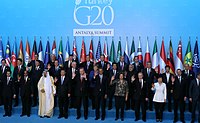
Photo from wikipedia
On January 6, 2016, the government of North Korea announced that it had exploded a hydrogen bomb (‘‘H-Bomb’’)—its fourth nuclear weapons test in the last decade. Much of the world… Click to show full abstract
On January 6, 2016, the government of North Korea announced that it had exploded a hydrogen bomb (‘‘H-Bomb’’)—its fourth nuclear weapons test in the last decade. Much of the world responded to the latest test with deep condemnation for a country that has the ability to destabilize an entire region because of its nuclear ambitions. After North Korea’s third nuclear detonation that took place on February 12, 2013, sentiments began to grow about the need for South Korea to arm itself with nuclear weapons in response to the growing threat posed from the north. During an interview with Korea JoongAng Daily, John Mearscheimer replied to a question about acknowledging North Korea as a de facto nuclear-armed country, stating that, ‘‘there is little doubt that North Korea is now a nuclear-armed state, although it has a very limited nuclear capacity at this point. However, that is likely to change over time because Pyongyang will surely acquire more nuclear weapons and better means to deliver them against other countries.’’ North Korea’s H-Bomb detonation, alongside the regime’s troubling rocket launch that took place in early February 2016 potentially leading to development of a nuclear-capable missile, calls for much deeper reflection about the testing and possession of nuclear weapons by all states, not simply the defiant ones, but also by the world’s nuclear liberal democracies like the United States, the United Kingdom, France, and others. Terrorism and Political Violence, 29:185–194, 2017 Copyright # Taylor & Francis Group, LLC ISSN: 0954-6553 print=1556-1836 online DOI: 10.1080/09546553.2016.1255070
Journal Title: Terrorism and Political Violence
Year Published: 2017
Link to full text (if available)
Share on Social Media: Sign Up to like & get
recommendations!